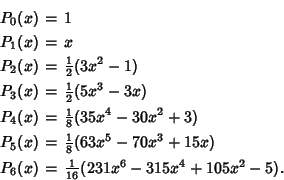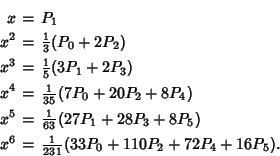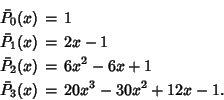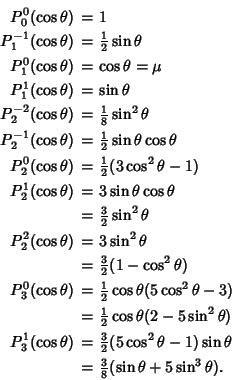|
|
|

The Legendre Functions of the First Kind are solutions to the
Legendre Differential Equation. If ![]() is an Integer, they are Polynomials. They
are a special case of the Ultraspherical Functions with
is an Integer, they are Polynomials. They
are a special case of the Ultraspherical Functions with ![]() . The Legendre
polynomials
. The Legendre
polynomials ![]() are illustrated above for
are illustrated above for ![]() and
and ![]() , 2, ..., 5.
, 2, ..., 5.
The Rodrigues Formula provides the Generating Function
| (1) |
 |
(2) |
 |
(3) |
 |
(4) |
 |
(5) |
![\begin{displaymath}
(1-2xt+t^2)^{-3/2}[(2xt-2t^2)+(1-2xt+t^2)] = \sum_{n=0}^\infty (2n+1)P_n(x)t^n
\end{displaymath}](l1_1347.gif) |
(6) |
 |
(7) |
| (8) |
The Legendre polynomials are orthogonal over ![]() with Weighting Function 1
and satisfy
with Weighting Function 1
and satisfy
| (9) |
A Complex Generating Function is
| (10) |
| (11) |
Additional integrals (Byerly 1959, p. 172) include
| (12) |
 |
(13) |
![\begin{displaymath}
1-[P_n(x)]^2=\sum_{\nu=1}^n {1-x^2\over 1-{x_\nu}^2} \left[{P_n(x)\over P_n'(x_\nu)(x-x_\nu)}\right]^2
\end{displaymath}](l1_1356.gif) |
(14) |
The first few Legendre polynomials are


The Legendre Polynomials can also be generated using Gram-Schmidt Orthonormalization in the
Open Interval ![]() with the Weighting Function 1.
with the Weighting Function 1.
| (15) | |||
![$\displaystyle \left[{x-{\int_{-1}^1 x\,dx\over \int_{-1}^1 dx}}\right]\cdot 1$](l1_1361.gif) |
|||
![$\displaystyle x-{{1\over 2}[x^2]^1_{-1}\over [x]^1_{-1}} = x-{{1\over 2}(1-1)\over 1-(-1)} = x$](l1_1362.gif) |
(16) | ||
![$\displaystyle \left[{x-{\int^1_{-1}x^3\,dx\over \int^1_{-1}x^2\,dx}}\right]-\left[{\int^1_{-1}x^2\,dx\over \int^1_{-1}dx}\right]\cdot 1$](l1_1364.gif) |
|||
![$\displaystyle \left[{x-{{1\over 4}[x^4]^1_{-1}\over {1\over 3}[x^3]^1_{-1}}}\right]x
- {{1\over 3} [x^3]^1_{-1}\over [x]^1_{-1}} = x^2-{\textstyle{1\over 3}}$](l1_1365.gif) |
(17) | ||
![$\displaystyle \left[{x-{\int^1_{-1}x(x^2-{1\over 3})^2\,dx\over \int^1_{-1}(x^2...
...}})-\left[{{\int^1_{-1}(x^2-{1\over 3})^2\,dx\over \int^1_{-1}x^2\,dx}}\right]x$](l1_1367.gif) |
|||
![$\displaystyle x\left[{x^2-{\textstyle{1\over 3}}-{({\textstyle{1\over 5}}-{\textstyle{2\over 9}}+{\textstyle{1\over 9}})x\over {\textstyle{1\over 3}}}}\right]$](l1_1368.gif) |
|||
| (18) |
The ``shifted'' Legendre polynomials are a set of functions analogous to the Legendre polynomials, but defined on the
interval (0, 1). They obey the Orthogonality relationship
| (19) |

The associated Legendre polynomials ![]() are solutions to the associated Legendre Differential Equation,
where
are solutions to the associated Legendre Differential Equation,
where ![]() is a Positive Integer and
is a Positive Integer and ![]() , ...,
, ..., ![]() . They can be given in terms of the unassociated polynomials by
. They can be given in terms of the unassociated polynomials by
 |
|||
 |
(20) |
| (21) |
Associated polynomials are sometimes called Ferrers' Functions
(Sansone 1991, p. 246). If ![]() , they reduce to the unassociated Polynomials. The associated
Legendre functions are part of the Spherical Harmonics, which are the solution of
Laplace's Equation in Spherical Coordinates. They are Orthogonal over
, they reduce to the unassociated Polynomials. The associated
Legendre functions are part of the Spherical Harmonics, which are the solution of
Laplace's Equation in Spherical Coordinates. They are Orthogonal over
![]() with the Weighting Function 1
with the Weighting Function 1
| (22) |
| (23) |
| (24) |
 |
|||
| (25) |
| (26) |
| (27) |
| (28) |
| (29) |
| (30) |


| (31) |
| (32) |
See also Condon-Shortley Phase, Conical Function, Gegenbauer Polynomial, Kings Problem, Laplace's Integral, Laplace-Mehler Integral, Super Catalan Number, Toroidal Function, Turán's Inequalities
References
Abramowitz, M. and Stegun, C. A. (Eds.). ``Legendre Functions'' and ``Orthogonal Polynomials.'' Ch. 22 in
Chs. 8 and 22 in Handbook of Mathematical Functions with Formulas,
Graphs, and Mathematical Tables, 9th printing. New York: Dover, pp. 331-339 and 771-802, 1972.
Arfken, G. ``Legendre Functions.'' Ch. 12 in
Mathematical Methods for Physicists, 3rd ed. Orlando, FL: Academic Press, pp. 637-711, 1985.
Binney, J. and Tremaine, S. ``Associated Legendre Functions.'' Appendix 5 in
Galactic Dynamics. Princeton, NJ: Princeton University Press, pp. 654-655, 1987.
Byerly, W. E. An Elementary Treatise on Fourier's Series, and Spherical, Cylindrical, and Ellipsoidal Harmonics,
with Applications to Problems in Mathematical Physics. New York: Dover, 1959.
Iyanaga, S. and Kawada, Y. (Eds.). ``Legendre Function'' and
``Associated Legendre Function.'' Appendix A, Tables 18.II and 18.III in Encyclopedic Dictionary of Mathematics.
Cambridge, MA: MIT Press, pp. 1462-1468, 1980.
Legendre, A. M. ``Sur l'attraction des Sphéroides.'' Mém. Math. et Phys. présentés à l'Ac. r. des. sc. par
divers savants 10, 1785.
Morse, P. M. and Feshbach, H. Methods of Theoretical Physics, Part I. New York: McGraw-Hill, pp. 593-597, 1953.
Press, W. H.; Flannery, B. P.; Teukolsky, S. A.; and Vetterling, W. T.
Numerical Recipes in FORTRAN: The Art of Scientific Computing, 2nd ed. Cambridge, England: Cambridge
University Press, p. 252, 1992.
Sansone, G. ``Expansions in Series of Legendre Polynomials and Spherical Harmonics.''
Ch. 3 in Orthogonal Functions, rev. English ed. New York: Dover, pp. 169-294, 1991.
Snow, C. Hypergeometric and Legendre Functions with Applications to Integral Equations of Potential Theory.
Washington, DC: U. S. Government Printing Office, 1952.
Spanier, J. and Oldham, K. B. ``The Legendre Polynomials
Szegö, G. Orthogonal Polynomials, 4th ed. Providence, RI: Amer. Math. Soc., 1975.
![]() '' and ``The Legendre Functions
'' and ``The Legendre Functions ![]() and
and
![]() .'' Chs. 21 and 59 in An Atlas of Functions.
Washington, DC: Hemisphere, pp. 183-192 and 581-597, 1987.
.'' Chs. 21 and 59 in An Atlas of Functions.
Washington, DC: Hemisphere, pp. 183-192 and 581-597, 1987.
|
|
|
© 1996-9 Eric W. Weisstein